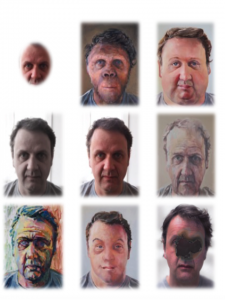Darren Griffin and award winning portrait artist Keith Robinson recently joined forces to initiate a project that combines genomics and portraiture. The project is ongoing and the idea is to represent each human chromosome 1-22, X, Y plus the mitochondrial DNA, each as a separate version of the same face. In this case the face is that of the artist Keith. Many aspects of genetics and genomics will be considered including disease, variation, evolution, behaviour, development and environmental interaction.
Darren said “the real challenge was, how do we represent a chromosome as a self portrait? There are issues of style of painting, manipulating the face, seeing a disease through the eyes of the sufferer and even visual puns. Basically we start the process by me coming up with ideas and doing a very crude version of the portrait using apps such as “Oldify” or “Fatify” – Keith then does a more professional version using image manipulation software ahead of working his magic by creating a portrait.”
The idea is to try and create a total of 25 portraits and Keith will be visually referencing art history and popular culture with some of them. The team (which also includes Keith’s brother Gary (Kent Innovation and Enterprise and the School of Biosciences)) will also try to raise science communication funds to see if they can complete the collection and enter some national exhibitions.
If all goes well then stage 2 will be to create a digital arts program that generates an individualized “25-image grid” reminiscent of an Andy Warhol piece based on Keith’s portraits of anyone that chooses it. This would be a personal “gift” item and we have already tried this out on one or two willing “victims.” The team plan to work with colleagues in Digital Arts to achieve this. If they can continue to get funding, the final stage will be to create interactive mirrors – a sort of digital version of the “curved mirrors” you see in fairgrounds. The concept would be that the viewer could go into a gallery and look into an iPad – their “reflection” would be one of these digital images in real time.
One aim of the project is to challenge notions of disease as compared to natural variation (often the two are not easily distinguished). What is “normality” and what is mutation? The project will also challenge the notion of disability (e.g. how would someone feel seeing themselves as portrayed as someone with Down Syndrome (how would someone with Down Syndrome feel?)) as well as bringing the concepts of genetics and genomics to the general public in an accessible way.
A snapshot of some of the work in progress. The top-left, middle-left and bottom-right panels represent disease and variation through the eyes of the beholder (chromosomes 1 (retinitis pigmentosa), 7 (blue yellow colour blindness) and mitochondrial DNA (optical neuropathy) respectively). The top-middle panel represents evolution (chromosome 2). The top-right panel represents genes on chromosome 3 that are related to fatness, the middle-right panel (chromosome 8) represents ageing, the bottom-left panel (chromosome 10) represents stress and the bottom-middle panel (chromosome 21) Down syndrome. The centre panel (chromosome 17) is left unaltered to represent cancer as this is something that affects the lives of everyone.
